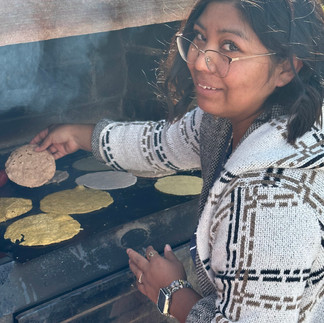A Tapestry of Maize: Our Collective Homage to Indigenous Wisdom
- Frontline Farming 👩🏽🌾
- Nov 30, 2023
- 6 min read
Updated: Dec 3, 2023
“Umuntu ngumuntu ngabantu” -- “I am because you are”
- Zulu phrase


Embracing the essence of both Ubuntu and the rich tapestry of African and Indigenous cosmologies, where our existence is deeply intertwined with the cosmos, we at Frontline Farming have embarked on a sacred journey with maize. This journey, deeply rooted in the Indigenous stories of the Americas and the holistic, humanistic African worldview, has instilled in us a profound reverence for the maize seed. This odyssey took us through the entire lifecycle of corn – from seed saving to growing, and then onto the alchemical processes of nixtamalization, as we spun corn into gold. Like any good story, there is a satisfying ending as we shared tradition and nutrition through collective cooking of vibrant dishes like pozole rojo, tamales, both sweet and savory, and tortillas in every imaginable color. Our story is so much more than just growing corn; it’s an immersive experience into the rich tapestry of cultural practices deeply cherished by our farm crews and the network of community navigators. Our practice of farming includes laboring on the land, feeding soil, and raising plants from seed to fruit. But, it is also more than that. It is a way of being, as cooking and eating this food together with our brothers, sisters and siblings is part of a cycle of tending and nourishing our relations.
Project Protect Promotoras, who were honored guests and cooks at our 2023 Foodways Celebration of Maize, are a network of community navigators across Colorado’s agricultural regions who specialize in culturally and linguistically tailored outreach designed to educate agricultural workers, distribute resources, and facilitate access to service providers. Most of these incredible individuals hail from Mexico and Central America and dedicate themselves to advocating for farm workers. These Promotores hold dear their relationships with Colorado agricultural workers because they themselves have direct experience in formwork, either through family or their own first hand-experience. FrontLine Farming and Project Protect Food System Workers are sisters in this work to seek justice, respect, and love for agricultural workers in Colorado.
As farmers and staff at Frontline Farming, the Celebration of Corn this year meant the world to us. Our diligent work on the land led to the opportunity to honorably give back to the people for whom this crop is sacred. For our farm crews, many of whom were closely aligned with the Project Protect Promotora Network, growing corn and using it in community with our compañeras del campo was not just an act of agriculture but a gesture of deep respect and solidarity. It symbolized a cycle of nourishment and care, where the fruits of our collective labor were shared with those who dedicate their lives to the wellbeing of agricultural workers. We created a space to share in ceremony, to remember our homelands, and to rekindle the ways of being together, unified by the corn we cultivated.

As farmers and land stewards with ancestors from places near and far, we embarked on a journey to understand maize, a crop not necessarily native to each of our heritages yet having deep roots on the land we now steward. For example, in Ethiopia corn is integral to our cuisine, but it's used differently from the sweet corn popular in the U.S., where it often feeds animals. This contrast is one of the many contexts that set the stage for our exploration into the diverse world of corn.
In studying the science and cultivation practices of Indigenous stewards of occupied Turtle Island, it is clear that the tradition of planting corn, beans, and squash is a widespread practice, not localized to a specific region. While the Haudenosaunee (Iroquois or People of the Longhouse), are often recognized as the storytellers of the Three Sisters legend, other growers and farmers from these lands developed the milpa farming practice and told their own stories to educate their children. As we became story-listeners in this foodway, we gained insights into the profound relationship between people and corn. This path led us to embrace this method of farming.

We now always companion plant maize, beans, and squash in the same soil. In this symbiotic relationship, the cornstalks act as trellises for the climbing beans, the beans fix nitrogen in the soil, stabilizing the maize, and the broad leaves of the squash provide ground shade, helping to retain moisture and suppress weeds. This practice not only optimizes land use but also promotes a balanced ecosystem, enhancing soil fertility and sustainability without tilling. The wide-spread Indigenous method of planting in mounds is an elegant example of sustainable agriculture, showing us how every aspect of corn cultivation can be infused with respect and understanding for the natural world.
On FrontLine’s farms, we've focused on flint corn cultivation, a journey that began with seed saving and led to an appreciation of corn processing. This pursuit of knowledge has been a cornerstone of our work, bridging the gap between traditional and modern farming practices.
A Trio of Corn (Examples of what we grow)
Oaxacan Green Dent Corn: Unveiling Truths Amidst Controversy
 | The Oaxacan Green Dent Corn, with its alluring emerald kernels, at first seemed to whisper tales from Oaxaca. But as we delved deeper, we discovered its true story—one not of Mexican origins but of mistaken identity and misplaced heritage. It has proven difficult to trace its lineage to the region and may actually come from a US-based breeder. This revelation was a powerful reminder of the importance of understanding the true origins of what we nurture, acknowledging the widespread issue of biopiracy where seeds and heritage names are often misappropriated. Though shrouded in controversy, this corn, still stands as a majestic testament to nature's beauty, urging us to seek authenticity and honor the real stories of our seeds. |
|---|
From Bloody Butcher to Pomegranate Corn: Renaming and Reclaiming
 | The Bloody Butcher Corn, with its deep, crimson kernels, originally bore a name that echoed a violent past. In our journey to honor the sanctity of nature and its offerings, we chose to rename it to Pomegranate Corn while planting her in our fields. This act of renaming was not just a change of a label but a step towards healing and reconnection with the earth. Each red kernel became a symbol of life, renewal, and the enduring resilience of nature. |
|---|
Glass Gem Corn: Nature's Kaleidoscope
 | The Glass Gem Corn, a varietal as stunning as nature's own art, brought a spectrum of shimmering colors to our fields. Each cob was a celebration of diversity and beauty, a reminder of how varied and wondrous nature can be. This variety, beyond its visual splendor, also taught us about versatility as we learned it could be transformed into delightful popcorn, adding another dimension to our appreciation of this extraordinary plant. |
|---|

Connecting Tradition and Innovation
Corn is a constant companion for us as farmers traveling across space and time, symbolizing adaptability and growth. It teaches us the importance of listening to the land, understanding its rhythms, and respecting the wisdom passed down through generations. As we nurtured these plants, we found ourselves nurturing a connection to a larger story—a narrative that spans continents, cultures, and times.
The harvest itself is a joy and a surprise. Each ear is unique in color, kernel patterning, size, and morphology. We delight in the unwrapping of husks and receive each ear as a present. The corn expresses agency to become its unique fully expressed self. It is clear that Indigenous people took their cues from the corn-teacher and created social structures that were similarly diverse, unique, self-determined, and free to be as we are. Profound freedom was here before American rhetoric turned the story upside down – in multiple and inspiring iterations of social organization.

Braiding
The artful practice of braiding corn and hanging it to dry, invokes our ancestors and their knowledge of seasons and food security before modernity. It binds us – to the harvest, to the end of the summer season, to the earthy decor of edible art hanging in our homes or drying at the farm, and to countless other relatives enacting the same ancient ritual with our primary staple and teacher; maize.
Nixtamalization & Indigenous Science
When colonial powers took corn back to Europe to cultivate, or rather to “produce”, it became a rather debased food; suitable only for livestock feed. How our relative, our teacher, our ancestor, the maize itself became debased was probably a devaluing of Indigenous science. Native ancestors knew that the corn needed to be slow-cooked in an alkaline substance (wood ash or slaked lime), then soaked, rinsed, and finally ground into masa. The colonial gaze, intent on acquisition and blind to the nuances of Indigenous knowledge, overlooked the miracle of preparation to create chemical changes making it more fit for human consumption. This brilliant process is known as Nixtamalization.
Nixtamalization enhances the nutritional value of corn by increasing its niacin (vitamin B3) availability and reducing harmful mycotoxins. This process also improves the protein quality of corn, making it a more nutritious and healthful food source. We don't know how the people of ancient Mexico figured out how to make Nixtamal, but in the fashion of storytelling it is best to say, "The corn taught us." Besides profound freedom, our ancestors also practiced deep listening.

The day before our Corn Fest, we took our various corn kernels – Oaxacan Green, Purple Conico, Yellow Tuxpeño, and others – and cooked them in Cal (calcium hydroxide/slaked lime … the mineral, not the citrus), soaked them overnight, and rinsed them. As a small farm, we grew small batch corn and struggled to find a millstone that both fit the quantity and had availability. Of course, we were blessed and found a local torterilla, Tortilleria las Tres Americas, to grind them into fine masa at the very last minute.
Early on an October morning, with chill nipping at our noses, we welcomed the Project Protect Promotores onto Majestic View Farm to hold ceremony and bless the land. Talented and wise elders led us in showing thanks for the gifts of the land and showing honor and respect for all that the natural world provides, including and especially each other. From there, the miracle-working Promotoras took the masa, made from corn grown in the soil right under their feet, and fashioned it into tortillas, posole, and tamales. Skillful hands taught the practice to new learners. Younger generations learned an art that had been passed down for millennia.
We came from all four corners of Colorado and beyond, bringing traditions and empty bellies. We sang, we danced, we told stories, we taught and learned, we saved seeds, and most importantly, we ate!
Weaving Corn and People
This is, in total, a traditional communal process that weaves the sacred corn and the people together in relationship, nourishment, and reciprocity.
Our experience with maize at Frontline Farming is a metaphor for collective growth—of our community, understanding, and connection to the Earth. Each variety of maize has contributed to our collective tapestry of learning, nurturing a diverse community of voices, ideas, and cultures. It's a celebration of growth, not just of the crops, but of us as a community, our perspectives, and our shared future. In this journey, we embody the essence of Ubuntu, understanding that our existence and growth are intrinsically linked to each other and to the maize that sustains us.




















